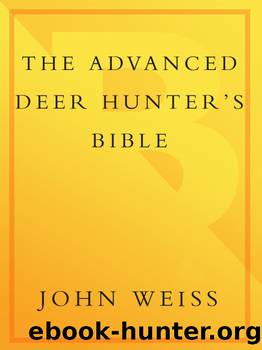Advanced Deerhunter's Bible by John Weiss

Author:John Weiss [Weiss, John]
Language: eng
Format: epub
ISBN: 978-0-307-78436-0
Publisher: Crown
Published: 2011-05-04T00:00:00+00:00
Boundary scrapes are a bit more complicated to describe, and they may or may not be productively hunted, depending upon several related circumstances. Boundary scrapes have all the usual scrape features, except one. They are of average size, they are located beneath tree branches which have been broken and chewed upon, but they seldom seem as fresh and steaming hot as other scrapes. This is because boundary scrapes are laid down around the outermost perimeter of a buckâs home range, and they are therefore visited less frequently than other scrapes where the buck spends most of his time. Because these particular scrapes randomly dot the periphery of the buckâs territory, knowing how to recognize typical home-range boundaries of deer will in turn help you to identify such scrapes.
Although it sometimes seems as though whitetail bucks are inclined to go anywhere they damn well please, radio-tracking studies have shown that they actually spend as much as 90 percent of their time in about a 40-acre âcore area,â in which they have the best combination of food, water and security cover at their immediate disposal. Furthermore, when they do periodically leave the safety of their core areas to venture into surrounding or outlying regions, they are reluctant to go beyond major man-made or natural barriers (assuming, of course, that they are not being chased by dogs or being subjected to intense hunting pressure). Because these obstacles tend to restrict the bucksâ travels, the obstacles, in large part, serve to establish the irregularly shaped home ranges (usually no more than two square miles in size) in which the bucks are destined to live out their entire lives.
Just a few examples of home-range boundaries, or barriers, include superhighways (especially if they are bordered by high fences), wide river courses, lakeshores, sheer rock bluffs, steep mountain ridges, canyon rims, and even those particular forest edges that yield to wide expanses of prairie or open ground. There is a great likelihood that scrapes found along any of these types of well-defined edges are boundary scrapes.
Download
This site does not store any files on its server. We only index and link to content provided by other sites. Please contact the content providers to delete copyright contents if any and email us, we'll remove relevant links or contents immediately.
Backpacker the Complete Guide to Backpacking by Backpacker Magazine(2094)
The Isle of Mull by Terry Marsh(1781)
Capital in the Twenty-First Century by Thomas Piketty(1779)
Predation ID Manual by Kurt Alt(1562)
The Collected Non-Fiction by George Orwell(1508)
Small-Bore Rifles by C. Rodney James(1459)
All Fishermen Are Liars by John Gierach(1349)
Creative Confidence by Tom Kelley(1339)
Backcountry Bear Basics by Dave Smith(1339)
The Art of Throwing by Amante P. Marinas Sr(1288)
50 Famous Firearms You've Got to Own by Rick Hacker(1279)
Blood Mountain by J.T. Warren(1261)
Archery: The Art of Repetition by Simon Needham(1248)
Long Distance Walking in Britain by Damian Hall(1234)
Backpacker Long Trails by Backpacker Magazine(1194)
The Fair Chase by Philip Dray(1154)
The Real Wolf by Ted B. Lyon & Will N. Graves(1152)
The Ultimate Guide to Home Butchering by Monte Burch(1141)
The Ultimate Shooting Skills Manual: 212 Essential Range and Field Skills (Outdoor Life) by The Editors of Outdoor Life(1126)
